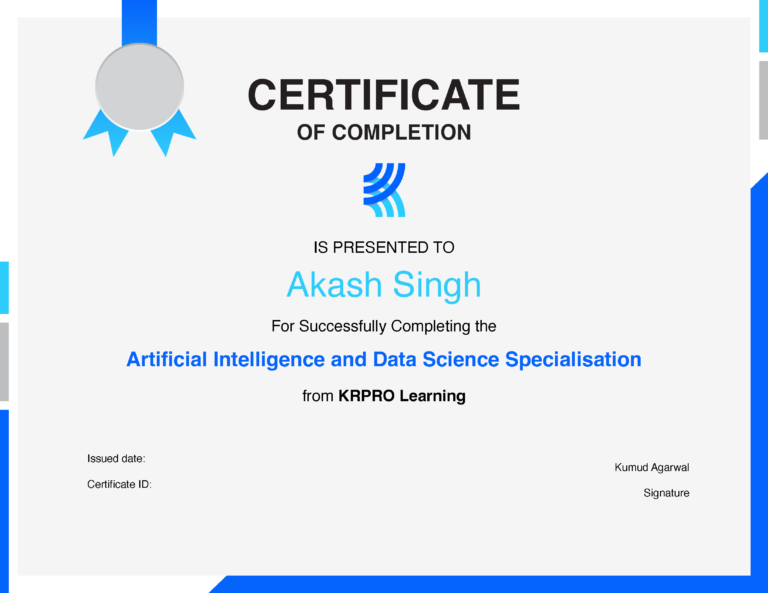Artificial Intelligence and Data Science Specialisation
Offline • Online • 12 Months
Learn Artificial Intelligence and Data Science through our specialised program. Acquire practical skills and theoretical insights essential for success in this dynamic and high-demand industry.
No prior programming experience required
Scholarship available*
Communication and Soft skills Training
About the course
Embark on a journey with our AI and Data Science Specialization course, a comprehensive online learning experience designed to equip learners with vital skills in artificial intelligence (AI), machine learning, and data science. This course offers hands-on experience with industry-standard tools and techniques, ensuring readiness to tackle real-world data challenges effectively. Whether you’re a novice looking to start a career in AI or a seasoned professional seeking to enhance your skills, this course offers the essential knowledge to excel in the dynamic fields of AI and data science.
- No prior programming experience required
- Industry graded projects
- Certificate of completion
- Communication and Soft skills Training
- Guest lectures by industry professionals
- Learn by doing practical
Comprehensive curriculum
Introduction to Python Programming
- Introduction to the Jupyter Notebook environment. Basics Jupyter notebook Commands.
- Syntax, variables, and Data types.
- Data structures in python – List, Tuple, Set, Dictionary
- Conditional statements – if, Else, Elif.
- Loops – While & For Loops.
- Functions – lambda, recursions, map, filter & reduce functions.
- User-Defined Functions
- Errors and Exceptions- Try and Except
- List and Dictionary Comprehension
Data analysis using python
- Pandas
- Numpy
- Data Cleaning – null and infinite values, outliers, capping, sanity
checks, data formatting, etc. - Types of Variables – Categorical & Continuous
- Visualization Libraries: Seaborn and Matplotlib
- Exploratory Data Analysis: Univariate, Bivariate, and Multivariate analysis.
Statistics
- Introduction to Statistics
- Basics of Probability
- Discrete Probability Distribution
- Continuous Probability Distribution
- Normal Distribution
- Poisson’s Distribution
- Bayes’ Theorem
- Central Limit Theorem
- Pearson Co-Relation, Co-Variance
- Creating confidence interval for the population parameter
- Characteristics of Z-distribution and T Distribution.
- Concepts of Hypothesis Testing: Null and Alternate Hypothesis
- Making a Decision and Critical Value Method
- p-Value Method and Types of Errors
- Two-Sample T-Test
- Two sample Z-test
- ANOVA, Chi-Square, A/B Testing
Supervised Learning – Regression
- Simple Linear Regression
- Multiple Linear Regression
- Ridge & Lasso Regression (L1 & L2)
Supervised Learning – Classification
- Logistic Regression
- KNN Algorithm
- Naive Bayes
- Decision Trees
- Random Forest
- Support Vector Machines
Supervised Learning – Ensemble
- Bagging and Boosting
- Xgboost Algorithm
- Adaboost Algorithm
- VotingClassifier
- Gradient Boosting Algorithm
Unsupervised Learning
- Introduction to Clustering
- K-Means Clustering: Linkage, Use of Elbow Curve & Silhouette
Score - Hierarchical Clustering
- Principal Component Analysis (PCA
- Introduction to Deep Learning and Neural Networks
- Introduction to Linear Algebra
- TensorFlow & Keras for Neural Networks
- Artificial neural Networks (ANN)
- Image Classification using Convolutional
- Neural Networks (CNN)
- Transfer Learning
- Recurrent neural networks – Natural Language processing
MLOPS/Model Deployment
Machine Learning model deployment with Industry level architecture
- Introduction to Generative AI & LLMs
- LangChain Framework
- Embeddings & Vector Databases
- Retrieval-Augmented Generation (RAG)
- Industry relevant projects
- Mentorship by industry experts
- Communication Skills
- Body Language & First Impressions
- Personal Branding
- Interpersonal Skills
Earn a certificate upon course completion

* Image for illustration only. Certificate subject to change.
The learning environment here is great. The coaching centre provides everything we need so that we are not disturbed while studying. The facilities in the classroom are top quality, making it perfect for learning. I believe it is worth it for anyone who wants to join. The faculty members are very supportive. Their teaching style is excellent and easy to understand. They always make sure we get the concepts and are always available to help us with any questions. We also have weekly doubt sessions which are very helpful. So far, I have really enjoyed studying at KRPro.

Personality Development Training Included at No Extra Cost

Communication Skills

Body Language & First Impressions

Personal Branding

Interpersonal Skills
Frequently asked question
This course is for anyone who wants to learn Data Science and AI. No prior coding knowledge is needed—we start from basics and guide you step by step.
Fee structure can be divided into Monthly instalments.
Yes, candidate have to use their own laptop.
There will be multiple projects for each learning module, although capstone project is the main project at the end of the course.
We will provide you with certification, which you can use in your portfolio.
Candidates are evaluated in the course through a series of tests and quizzes.
Contact us
We don’t prov








